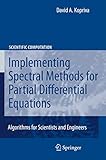Implementing spectral methods for partial differential equations : algorithms for scientists and engineers
Series: Scientific ComputationPublication details: Dordrecht: Springer, [c2009]Description: 394 pISBN: 9789048122608Subject(s): Partial differential equations | Spectral theory (Mathematics)LOC classification: QA377 .K667Online resources: Click here to access online| Item type | Current library | Call number | Status | Date due | Barcode | Item holds |
|---|---|---|---|---|---|---|
 Book
Book
|
ICTS | QA377 .K67 (Browse shelf (Opens below)) | Checked out to Mohammad Saif Khan (0007747091) | 01/13/2025 | 02873 |
Part I - Approximating Functions, Derivatives and Integrals:
1.Spectral Approximation.
2.Algorithms for Periodic Functions.
3.Algorithms for Non-Periodic Functions.
Part II - Approximating Solutions of PDEs:
4.Survey of Spectral Approximations.
5.Spectral Approximation on the Square.
6.Transformation Methods from Square to Non-Square Geometries.
7.Spectral Methods in Non-Square Geometries.
8.Spectral Element Methods.
A. Pseudocode Conventions.
B. Floating Point Arithmetic.
C. Basic Linear Algebra Subroutines (BLAS).
D. Linear Solvers.
E. Data Structures.
References. Index of Algorithms. Subject Index.
This book offers a systematic and self-contained approach to solve partial differential equations numerically using single and multidomain spectral methods. It contains detailed algorithms in pseudocode for the application of spectral approximations to both one and two dimensional PDEs of mathematical physics describing potentials, transport, and wave propagation. David Kopriva, a well-known researcher in the field with extensive practical experience, shows how only a few fundamental algorithms form the building blocks of any spectral code, even for problems with complex geometries. The book addresses computational and applications scientists, as it emphasizes the practical derivation and implementation of spectral methods over abstract mathematics. It is divided into two parts: First comes a primer on spectral approximation and the basic algorithms, including FFT algorithms, Gauss quadrature algorithms, and how to approximate derivatives. The second part shows how to use those algorithms to solve steady and time dependent PDEs in one and two space dimensions. Exercises and questions at the end of each chapter encourage the reader to experiment with the algorithms.
---summary provided by the publisher


There are no comments on this title.